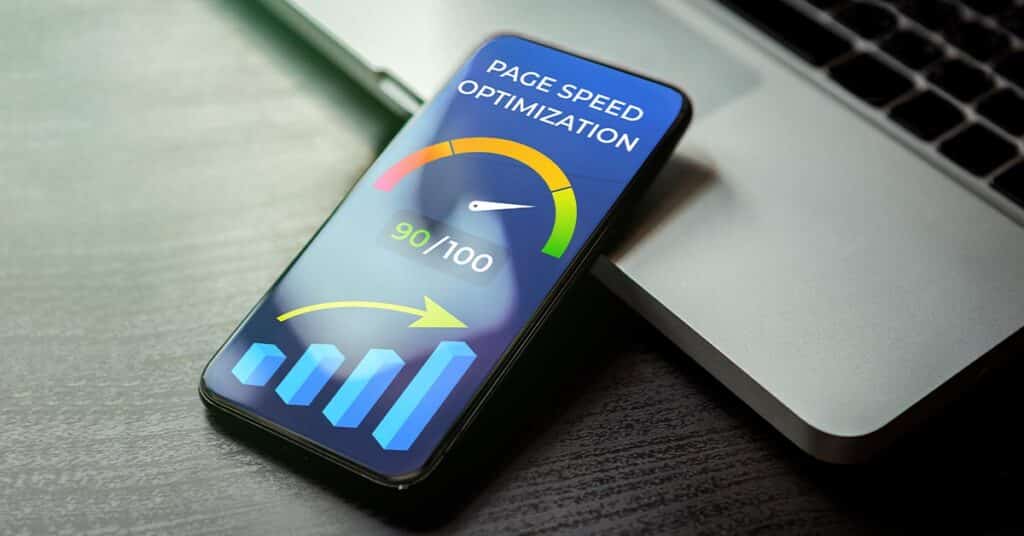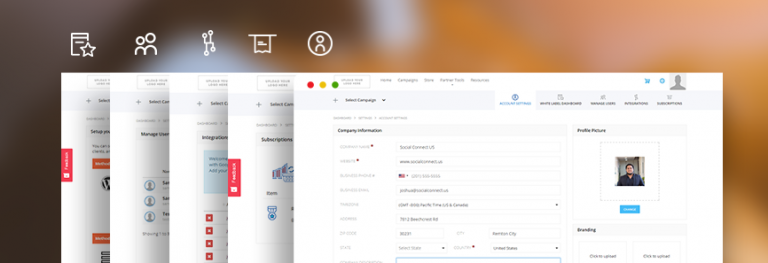With rapid digitalization, information flows at the speed of light, and user attention spans are becoming shorter. Studies reveal that the average user spends 54 seconds on a webpage before deciding to engage further or move on. That’s the blink of an eye in the digital realm.
This fleeting window of opportunity underscores the critical importance of a well-optimized website. It’s the key to capturing your audience’s attention, engaging them, and driving conversions. With that in mind, it’s best to develop a website optimization strategy to ensure the user experience is seamless and enjoyable.
Why do Users Leave A Site?
Users today have high expectations for their web experiences, and any misstep can lead to abandonment. Understanding the factors that drive users away from a website is crucial for maintaining a strong online presence.
Confusing Navigation
Confusion can be the kiss of death for a website. When users can’t easily find what they’re looking for, frustration sets in, and they’re likely to bounce. This often happens when a website lacks clear menus, labels, or intuitive design. Visitors should be able to navigate seamlessly, knowing where to click and how to access the content or products they desire. Simplifying navigation by organizing content logically and implementing a user-friendly menu structure can keep users engaged and encourage exploration, reducing the risk of abandonment.
Slow Checkout Process
A protracted and complicated checkout process can be a significant turnoff for potential customers. Users who have gone through the effort of selecting products or services don’t want to be bogged down by a tedious, multi-step checkout.
To prevent this, streamline the process by minimizing form fields, offering guest checkout options, and providing clear progress indicators. A swift and hassle-free checkout ensures a smoother transition from browsing to conversion, reducing cart abandonment rates and boosting sales.
Unclear Benefits of Converting
Users are more likely to take action when they understand the benefits of doing so. Visitors may hesitate or simply leave if a website fails to clearly communicate the value or rewards of converting.
It’s essential to convey the unique selling points, benefits, and incentives of your products or services prominently and persuasively. Utilize compelling visuals and persuasive copy to leave no doubt in the visitor’s mind about the advantages of taking the desired action, increasing the likelihood of conversion. You can get ideas from competitors to ensure that your website stands out and entices users.
Slow Website
Nobody likes waiting, especially when browsing online. A slow-loading website can be infuriating for users, leading to immediate abandonment. Factors like oversized images, excessive plugins, or server issues can contribute to sluggish performance.
Implementing optimization techniques, such as image compression, browser caching, and using a Content Delivery Network (CDN), can significantly improve page load times. A faster website keeps users engaged and contributes to better search engine rankings, making it a critical element of a successful online presence.
What Is Website Optimization?
Website optimization systematically improves a website’s performance, usability, and functionality to enhance user experience, increase traffic, and achieve specific business objectives. It involves various strategies and techniques aimed at optimizing different aspects of a website, such as its speed, content, design, and overall functionality, with the ultimate goal of driving better results, whether in terms of conversions, user engagement, or search engine rankings.
Here’s a table comparing website optimization with web design and development:
|
Aspect |
Website Optimization |
Web Design |
Web Development |
|
Focus |
Enhancing existing sites |
Visual and aesthetic |
Building and coding |
|
Goal |
Improve performance, UX |
Create visual appeal |
Create functional site |
|
Timeframe |
Ongoing and iterative |
Initial design phase |
Development phase |
|
Activities |
Content, speed, SEO |
Layout, graphics, UI/UX |
Coding, database, CMS |
|
User Experience (UX) |
Enhancing UX |
Focused on UX design |
Concerned with usability |
|
Changes and Updates |
Frequent adjustments |
Occasional updates |
Periodic maintenance |
|
SEO Integration |
Integral for SEO |
SEO considerations |
SEO-friendly structure |
|
Audience Engagement |
Improving engagement |
Initial attraction |
Functionality and usability |
|
Aesthetics |
Improved within limits |
Primary focus |
Less aesthetic concern |
|
Key Tools |
Analytics, A/B testing |
Design software/tools |
Programming languages |
The Benefits of Website Optimization
Increase User Time on Site
Website optimization helps increase the average user time on a site by improving the overall user experience. When a website loads quickly, is easy to navigate and offers engaging content, visitors tend to stay longer and explore more. Optimized websites capture and hold user attention, which reduces bounce rates and increases the chances of users finding valuable content, products, or information. A longer time on site indicates user satisfaction and creates more opportunities for conversions, such as newsletter sign-ups, purchases, or consuming more content.
Provide a Better User Experience
Website optimization is all about improving the user experience. By focusing on factors like page speed, responsive design, and easy navigation, you can create a visually appealing and user-friendly website. This helps visitors have a positive perception, trust the site, and explore more. A better user experience leads to higher satisfaction, increased engagement, and a greater chance of users achieving their goals on the site, whether it’s finding information, making purchases, or interacting with content.
Leads to More Return Visits
Optimized websites leave a lasting impression, encouraging visitors to return. When users have a positive experience during their initial visit, they are more likely to remember the website and its value. Additionally, optimized sites tend to rank better in search engines, making them easier to rediscover.
Through consistent content updates, personalized experiences, and effective engagement strategies, website optimization fosters a sense of loyalty among users, transforming them into repeat visitors. This not only increases brand recognition but also creates opportunities for continued interaction and conversions.
Increase E-commerce Sales
For e-commerce websites, website optimization is a direct path to increased sales. A fast-loading, user-friendly website with clear product descriptions, intuitive navigation, and streamlined checkout processes can significantly boost conversion rates.
Optimized product pages, tailored recommendations, and simplified purchase flows make it easier for shoppers to find, select, and purchase products. Additionally, SEO optimization helps attract more qualified traffic, increasing the chances of turning visitors into paying customers. The result is higher revenue, improved customer satisfaction, and a more successful online retail operation.
Areas of Website Optimization
Website Architecture
Website architecture focuses on the structure and organization of a website. It involves creating a logical, user-friendly layout that ensures easy navigation and access to content. Effective website architecture helps users find what they’re looking for quickly and intuitively. It also impacts search engine optimization (SEO) by making it easier for search engine crawlers to index and rank your content.
Key considerations in website architecture include clear menus, a hierarchical page structure, proper linking, and a sitemap. A well-structured architecture enhances user experience and supports other optimization efforts.
Design
Website design encompasses a website’s visual elements and user interface (UI). It’s about creating an appealing, intuitive look and feel that aligns with your brand and engages visitors. A good design enhances user experience, encourages interaction, and communicates your message effectively.
Key design elements include layout, color schemes, typography, images, icons, and the overall aesthetic. Design optimization ensures your website is visually compelling, user-friendly, and responsive to different devices and screen sizes.
Content
Content optimization revolves around the quality, relevance, and presentation of the information on your website. High-quality content is crucial for engaging users and achieving SEO goals. Optimization includes keyword research and placement, clear and concise writing, multimedia integration, and ensuring content is up-to-date.
Content that provides value to your audience, answers their questions, and aligns with their needs and interests is more likely to attract and retain visitors. It also plays a significant role in search engine ranking, as search engines prioritize valuable and informative content.
Optimization
Mobile Optimization
With the increasing use of mobile devices for web browsing, optimizing your website for mobile users is crucial. This means ensuring your site provides a seamless and responsive experience on smartphones and tablets. Mobile optimization includes improving page load times for mobile connections, making content easy to read on small screens, and implementing touch-friendly navigation. A mobile-friendly website reaches a broader audience and improves search engine rankings, as search engines prioritize mobile-friendly sites in mobile search results.
Testing and Analytics in Optimization
Testing and analytics are critical aspects of ongoing website optimization. A/B testing, user testing, and analytics tools allow you to gather data and insights about user behavior and site performance. A/B testing helps you experiment with different elements of your website (such as headlines, call-to-action buttons, or page layouts) to determine what resonates best with your audience. User testing involves getting direct feedback from users to identify pain points and areas for improvement.
Analytics tools like Google Analytics provide valuable data on user demographics, behavior, and traffic sources, helping you make data-driven decisions to enhance your website’s performance. These practices allow for continuous refinement and improvement of your site to better meet user needs and achieve your goals.
Common Website Optimization Mistakes to Avoid
Optimizing your website for better performance and user experience is a complex process that requires careful planning and execution. Here are a few common mistakes to avoid:
- Not Prioritizing Page Speed: Slow-loading pages can lead to high bounce rates. Optimize images, reduce server response times, and leverage browser caching to improve page load times.
- Ignoring SEO Best Practices: Neglecting search engine optimization (SEO) can result in lower visibility in search engine results. Pay attention to on-page SEO elements like meta tags, headings, and keyword optimization.
- Overlooking Content Quality: Low-quality content can harm your website’s reputation. Avoid duplicate content, grammatical errors, and thin, irrelevant content. Focus on providing valuable and informative content for your audience.
- Ignoring Security: Neglecting security can lead to data breaches and damage your reputation. Implement SSL certificates, regularly update software, and employ strong security measures to protect your website and user data.
- Ignoring User Feedback: User feedback is a valuable source of information for optimization. Pay attention to user reviews, comments, and suggestions to identify areas for improvement.
Frequently Asked Questions
Why is mobile optimization crucial?
Mobile optimization ensures your site is user-friendly and loads quickly on smartphones, catering to a mobile-first audience.
How does SEO impact optimization?
SEO enhances visibility and traffic by optimizing content and technical aspects for search engines.
What tools can help with website optimization?
Tools like Google Analytics, PageSpeed Insights, and A/B testing platforms assist in analyzing and optimizing your website effectively.
How can I optimize website load times?
Optimize images, enable browser caching, and reduce server response times to speed up your website’s loading.


